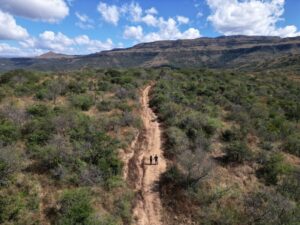The Science of How Being Outside in Nature Affects Our Bodies
For thousands of years, our bodies had to deal with the immense stress of living in the natural environment. We braved extremes of weather and were exposed to the sun, rain, animals and insects. We endured periods with minimal food and less than ideal shelters.
Nowadays, we have technology that allows us to microcontrol our external environment down to the exact degree of desired comfort. We can turn on steaming hot water at our chosen flow rate whenever we please. We can manipulate our exposure to light at all hours of the day with a simple push of a button.
One would think that with the removal of all these environmental stressors, modern humans should be rejoicing in their achievement of controlling the elements and relaxing in the cushy warmth of contemporary comforts. Yet, recent data suggests that present-day humans are more stressed out today than we were 30 years ago.
Why!?
Well, What is Stress Anyways?
The human stress response has evolved to do one thing: keep the human species alive. Its job is to maintain homeostasis under conditions of real or perceived threat. It does so through the activation of very complicated neural and hormonal systems which trigger cascades of chemicals such as epinephrine and cortisol. Let’s simplify our understanding of stress by focusing on the autonomic nervous system.
Your AUTOnomic nervous system controls the functioning of your internal organs and glands. This system functions unconsciously (or AUTOmatically). It is divided into your sympathetic and parasympathetic divisions.
- Your sympathetic nervous system (SNS) is your “fight or flight” system. This system would be activated if you came across a grizzly bear. Your heart rate would speed up, your pupils would dilate to let in more visual information and your body would direct more blood flow to your muscles and lungs so that you could get the hell outta there (flight) or FIGHT. This is your crisis mode survival system.
- Your parasympathetic nervous system (PNS) is the opposite. This is your “rest and digest” system. This system would be activated on a rainy Sunday afternoon where you decide to Netflix and Chill all day. Your heart rate slows down and your body directs more of its blood flow to your stomach and GI tract to assist with all of the UberEats. Oh, and your baby-making machinery gets more blood flow too… you can see how both of these systems are necessary for the survival of our human species!
So, activating your SNS essentially leads to an increased stress response while activating your PNS leads to relaxation. Simple, right?
How Sympathetic Overactivation is Leading to Chronic Stress
Our ancestors had their SNS fight or flight systems activated in emergencies only….an encounter with a predator, tribal wars, a storm approaching etc. Thankfully, due to the advancements of modern technology, we don’t deal with life-threatening emergencies on a day to day basis anymore (unless you happen to be an ER doctor).
But our SNS took millions of years to develop to ensure the survival of our species… and it hasn’t just disappeared. Rather, it has maladapted and now becomes activated by the minor stressors of our modern society instead. That stress you feel while stuck in traffic or with an approaching deadline- those are the same exact nerves firing, releasing the same stress hormones your body would release if you ran into a grizzly bear.
This is called an evolutionary mismatch, when a trait that has evolved is no longer advantageous due to changes of the environment. We will talk about other evolutionary mismatches in our next article.
Our bodies can handle short bursts of stress hormones just fine. Unfortunately though, what used to be reserved for surviving true “fight or flight” scenarios is now being triggered constantly and chronically, which slowly over time can wreak all sorts of havoc on your body and mind. Here’s a great documentary called Stress: Portrait of a Killer which discusses just how dangerous chronic stress actually is:
The Relationship Between Animals and Their Natural Environment
So, we have established that chronic stress is no bueno. We also realize that due to evolutionary mismatch, modern society and urbanization may be contributing to SNS overactivation. Can reverting to a more natural environment for which we were originally designed be a potential solution to this problem?
We can get a better idea of the impact nature has on our bodies by first looking at the relationship between animals and their environment. Ming Kuo, a researcher at the University of Illinois Urbana-Champaign, found from studying zoo animals that although they were provided with shelter, water, food and safety (everything their bodies technically need to survive) they were often not doing too well.
The Habitat Selection Theory postulates that animals are wired for whatever habitats they evolved in. This theory suggests that a species will do much better, both physically and psychologically, when they are in their “natural habitat”. This may explain why Kuo’s zoo animals, despite having everything they needed to survive, often did not thrive. (Listen to this fascinating Hidden Brain Podcast where Ming Kuo talks more about her findings.)
The Relationship Between Humans and Their Natural Environment
Do these findings apply to humans too? Humans have evolved into our current forms over hundreds of thousands of years. During that period, we have spent 99.99% of time living in the natural environment. According to The Biophilia Hypothesis, we have literally evolved to have an affinity for nature.
The Japanese have acknowledged this concept for a long time. The practice of Shinrin-yoku, or “forest bathing”, is actually promoted by the Japanese government as a beneficial health practice and doctors can even prescribe spending time in nature to their patients.
But how exactly does being in our natural environment have an influence on our minds and bodies? Multiple theories have arisen:
- Do you struggle with mental fatigue? Ever feel tired even though you haven’t done anything exertive? The Attention Restoration Theory (ART) states that mental fatigue from modern life is associated with a decreased ability to control your attention. Meaning, all the chaos and disruptions of modern life have made it harder for us to concentrate leading to literal exhaustion of our minds. ART suggests nature is the antidote. By spending more time outside we can “reset” our minds and improve our ability to focus. This in turn can help us gain more control of our daily attention span, therefore helping to reduce mental fatigue.
- Another theory, The Stress Reduction Theory (SRT) states that spending time in nature activates the PNS to reduce stress and autonomic arousal. Remember the PNS from above: our “rest and digest” anti-stress, Netflix and chill system? According to this theory you may be able to activate that system just by spending time outdoors!
- A more recent proposition by Ming Kuo suggests that the positive impact nature has on our bodies may come from enhanced immune functioning and restorative effects of nature on our bodies. She identifies 21 pathways comprised of environmental factors, physiological/psychological states and behaviors that have been scientifically linked to improved mental and physical health outcomes (see below).
Multiple scientific studies have now been done further investigating what effects spending time in nature can have on our physiology, psychology and lifespans. The results are remarkable! No pharmaceuticals with multiple side effects, no dramatic changes in your daily routine, no expensive financial commitments. Spending time outside is one of the lowest risk, cheapest, highest yield interventions you can make for your health right now. Let’s take a look at some of the amazing studies that have been done.
What Does the Scientific Literature Say About the Impact Of Nature on the Human Body
The Impact of Nature on Stress
A systematic review looking at 43 experimental studies found that spending time in nature (via outdoor walks, outdoor exercise, gardening) was associated with lower heart rates, cortisol levels (one of your stress hormones) and self-reported stress levels. Even just looking at a forest out of a window was found to decrease stress levels in employees.
The Impact of Nature on Cognitive Function
Multiple studies have now found that exposure to natural environments (when compared to urban environments) is associated with improved attention, executive function (higher brain functioning) and perceived restorativeness (how rested you feel). This association was found even after as little as 10 minutes of sitting or walking outside!
The Impact of Nature on Blood Pressure
Two meta-analyses (a review of multiple studies) found that exposure to a natural environment could statistically lower your blood pressure by 4-10 points. In comparison, losing 10 pounds can drop your BP by an average of 7 points, regular exercise can drop you 9 points, and antihypertensive medications can drop you by ~15 points. The studies found that this effect was even larger in people with preexisting hypertension. All of that just from some quality time with Mother Nature.
The Impact of Nature on Diabetes
One forest bathing study in Japan had 87 non-insulin dependent diabetic patients take a walk in the forest. They found that after just 30 minutes, their mean blood glucose levels dropped from 179 (high) to 108 (normal). This was a staggering 40% decrease! This effect was not seen when walking indoors.
The Impact of Nature on Vision
An Australian study following 2367 12-year-olds for two years found that playing outdoors was associated with lower rates of myopia, or near-sightedness. This association was not seen in kids that were equally active indoors. This systematic review of 16 experimental trials suggests there may be a 2% reduced odds of myopia per additional hour of time spent outdoors per week!
Another experimental trial with over 500 students in Taiwan looked at two nearby schools with equal rates of myopia. One school to encouraged outdoor activity during recess and the other school was used as a control. After just one year, rates of myopia in the control school were 17.65% compared to only 8.41% in the play-outside group. Playing outside is a lot cheaper (and more fun) than a lifelong subscription to corrective lenses.
The Impact of Nature on Mental Health
Some of the best research has been done on the effects of nature on mental health. One study followed 1 million residents of Denmark over 28 years and found that high levels of green space exposure in childhood was associated with lower risk of psychiatric disorders later in life. Another study of 94,879 UK adults found a protective effect of greenness on depression risk, especially for women, participants under 60, and those living in low socioeconomic or highly-urban neighborhoods.
A fascinating randomized controlled trial (a very strong experimental format) was performed in Philadelphia where 100 vacant lots were randomized to be cleaned and greened (by planting trees and grass), cleaned but not greened, or no intervention. What they found was people living around lots that were greened reported decreased levels of depression, poor mental health and feelings of worthlessness compared to those with no intervention. Those living around lots that were cleaned but not greened showed no difference when compared to the no intervention group.
Negative air ions, which are found in high concentrations in forests, mountains and near bodies of water, have been studied as effective treatments for depression and seasonal affective disorder.
The Impact of Nature on Immune Function
One study in Japan sent a small group of participants on a 3 day 2 night forest bathing trip while another group took the same trip in an urban area. They then measured natural killer cell activity (a major player in your immune system) on days 7 and 30 after the trip. For the forest bathing group, there was a 50% increase in natural killer activity by day 7 and a persistent 25% increase at day 30. This suggests spending time outside can literally BOOST your immune system and increase the amount of disease-fighting cells you have circulating in your blood!
We now know that phytoncides and mycobacterium vaccae, antimicrobial compounds found outside, have also been found to boost immune function as well.
The Impact of Nature on Post Operative Recovery
One study investigated post-surgical recovery in patients that had their gallbladders removed. The study compared patients who had a hospital room with a view of nature vs those with a brick wall for their view. Patients with a view of a natural setting had shorter hospital stays and took fewer pain killers than those facing a brick wall! Again, it appears even just SEEING a forest outside of your window may translate to positive effects on your body.
The Impact of Nature on Mortality
A study looking at 4.2 million adults in the Swiss National Cohort found high exposure to green space is associated with lower rates of death from natural causes, respiratory disease and cardiovascular disease. This was even after controlling for factors such as socioeconomic status, air pollution and noise exposure.
Another meta analysis looking at 8.3 million individuals from several countries around the world similarly found that higher levels of green space exposure is associated with lower levels of mortality. The authors recommended wide-scale interventions to increase and manage green spaces in order to improve public health outcomes.
Summary
We know this may have been an overwhelming amount of Science….but the simple summary is:
- Even though we no longer have to deal with the discomforts and threats of the natural environment anymore, it appears we are more chronically stressed now than ever.
- This is likely in part due to an evolutionary mismatch causing our SNS fight-or-flight system to be over activated by modern life stressors.
- More and more studies are suggesting that not only do we have a natural affinity to the outdoors, but that Mother Nature also seems to provide many psychological and physiological benefits to us which we are just beginning to understand.
- Spending time in our natural environment may decrease stress by improving our focus, activating our rest-and-digest PNS and boosting our immune systems.
- By taking just a 10 minute walk through some green space, you may be able to positively impact your cognitive functioning, vision, immune function and mental health while decreasing your stress hormones, blood pressure, blood glucose, recovery time and even mortality.
Again, spending more time outdoors is one of the lowest risk, cheapest, highest yield, most effective interventions you can start making for your health right now.
Need to run an errand? Walk instead of driving.
Got some calls to make? Take it outside.
Exercising anyways? Do it at the park.
While the Japanese have known about the benefits of forest-bathing for a long time, Canadian doctors are catching on and can now prescribe national park visits too! Americans work more hours and take less time off compared to most developed countries in the world. We could use the health benefits of forest-bathing more than anyone! So, today’s prescription:
PRESCRIPTION
Hug a tree. Jump in a body of water. Take a nice long walk. Visit a National Park. Or even just stop for a second to notice something beautiful.






